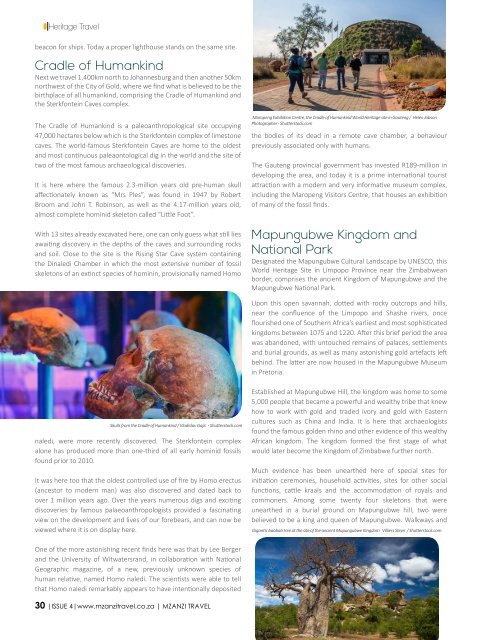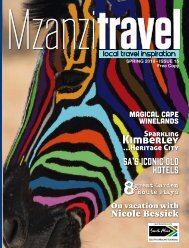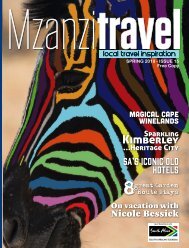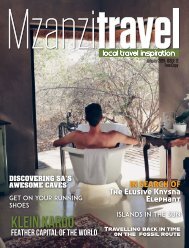Create successful ePaper yourself
Turn your PDF publications into a flip-book with our unique Google optimized e-Paper software.
Heritage Travel<br />
beacon for ships. Today a proper lighthouse stands on the same site.<br />
Cradle of Humankind<br />
Next we travel 1,400km north to Johannesburg and then another 50km<br />
northwest of the City of Gold, where we find what is believed to be the<br />
birthplace of all humankind, comprising the Cradle of Humankind and<br />
the Sterkfontein Caves complex.<br />
The Cradle of Humankind is a paleoanthropological site occupying<br />
47,000 hectares below which is the Sterkfontein complex of limestone<br />
caves. The world-famous Sterkfontein Caves are home to the oldest<br />
and most continuous paleaontological dig in the world and the site of<br />
two of the most famous archaeological discoveries.<br />
It is here where the famous 2.3-million years old pre-human skull<br />
affectionately known as “Mrs Ples”, was found in 1947 by Robert<br />
Broom and John T. Robinson, as well as the 4.17-million years old,<br />
almost complete hominid skeleton called “Little Foot”.<br />
With 13 sites already excavated here, one can only guess what still lies<br />
awaiting discovery in the depths of the caves and surrounding rocks<br />
and soil. Close to the site is the Rising Star Cave system containing<br />
the Dinaledi Chamber in which the most extensive number of fossil<br />
skeletons of an extinct species of hominin, provisionally named Homo<br />
Skulls from the Cradle of Humankind / Vladislav Gajic - Shutterstock.com<br />
naledi, were more recently discovered. The Sterkfontein complex<br />
alone has produced more than one-third of all early hominid fossils<br />
found prior to 2010.<br />
It was here too that the oldest controlled use of fire by Homo erectus<br />
(ancestor to modern man) was also discovered and dated back to<br />
over 1 million years ago. Over the years numerous digs and exciting<br />
discoveries by famous palaeoanthropologists provided a fascinating<br />
view on the development and lives of our forebears, and can now be<br />
viewed where it is on display here.<br />
Maropeng Exhibition Centre, the Cradle of Humankind World Heritage site in Gauteng / Helen Jobson<br />
Photographer - Shutterstock.com<br />
the bodies of its dead in a remote cave chamber, a behaviour<br />
previously associated only with humans.<br />
The Gauteng provincial government has invested R189-million in<br />
developing the area, and today it is a prime international tourist<br />
attraction with a modern and very informative museum complex,<br />
including the Maropeng Visitors Centre, that houses an exhibition<br />
of many of the fossil finds.<br />
Mapungubwe Kingdom and<br />
National Park<br />
Designated the Mapungubwe Cultural Landscape by UNESCO, this<br />
World Heritage Site in Limpopo Province near the Zimbabwean<br />
border, comprises the ancient Kingdom of Mapungubwe and the<br />
Mapungubwe National Park.<br />
Upon this open savannah, dotted with rocky outcrops and hills,<br />
near the confluence of the Limpopo and Shashe rivers, once<br />
flourished one of Southern Africa’s earliest and most sophisticated<br />
kingdoms between 1075 and 1220. After this brief period the area<br />
was abandoned, with untouched remains of palaces, settlements<br />
and burial grounds, as well as many astonishing gold artefacts left<br />
behind. The latter are now housed in the Mapungubwe Museum<br />
in Pretoria.<br />
Established at Mapungubwe Hill, the kingdom was home to some<br />
5,000 people that became a powerful and wealthy tribe that knew<br />
how to work with gold and traded ivory and gold with Eastern<br />
cultures such as China and India. It is here that archaeologists<br />
found the famous golden rhino and other evidence of this wealthy<br />
African kingdom. The kingdom formed the first stage of what<br />
would later become the Kingdom of Zimbabwe further north.<br />
Much evidence has been unearthed here of special sites for<br />
initiation ceremonies, household activities, sites for other social<br />
functions, cattle kraals and the accommodation of royals and<br />
commoners. Among some twenty four skeletons that were<br />
unearthed in a burial ground on Mapungubwe hill, two were<br />
believed to be a king and queen of Mapungubwe. Walkways and<br />
Gigantic baobab tree at the site of the ancient Mapungubwe Kingdom Villiers Steyn / Shutterstock.com<br />
One of the more astonishing recent finds here was that by Lee Berger<br />
and the University of Witwatersrand, in collaboration with National<br />
Geographic magazine, of a new, previously unknown species of<br />
human relative, named Homo naledi. The scientists were able to tell<br />
that Homo naledi remarkably appears to have intentionally deposited<br />
30 |ISSUE 4|www.mzanzitravel.co.za | MZANZI TRAVEL

















